Face Masks: Gearing Up for Mass Production to Fight COVID-19
Summary
- Zortrax put together an assembly line producing face masks in response to the COVID-19 pandemic.
- Masks are donated to hospitals, nursing homes, and other entities fighting the pandemic.
- The line works with over 100 components that have been made on Zortrax 3D printers.
Over 27 thousand new COVID-19 cases have been confirmed in Poland on a single day at the peak of the pandemic’s second wave. The virus has already claimed nearly 16 thousand lives in our country alone, over 300 thousand in Europe, and nearly 1.5 million worldwide.
Healthcare services are strained close to a breaking point, as we are quickly running out of hospital beds, lung ventilators, and basic personal protective equipment. That’s why, to keep our relief efforts relevant, we used our 3D printing resources as a springboard to quickly launch a full-scale manufacturing line producing face masks. These face masks are being distributed for free to medical staff and caretakers in Poland and around the world. We believe nobody with sufficient means at their disposal should remain indifferent when people are dying.
3D Printing Farm for Greater Good
Back in Spring, during the first wave of the pandemic, Zortrax was heavily involved in COVID-19 relief efforts worldwide. We were manufacturing face shields using our farm of over 100 3D printers which normally work in a variety of tasks such as prototyping of new products, testing new materials, and fabricating models for our on-demand 3D printing service.
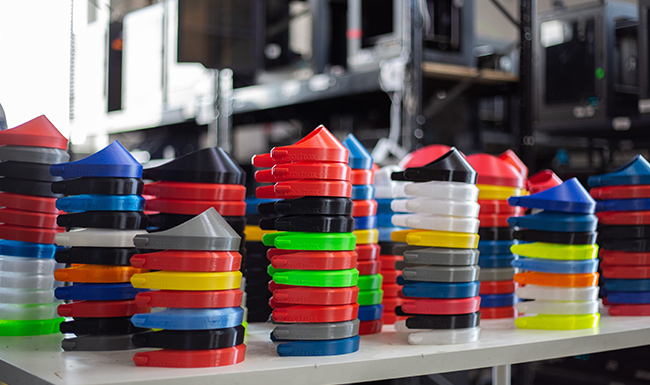
A batch of face shields 3D printed by Zortrax during the first wave of the pandemic.
These face shields were then being delivered to hospitals, and other institutions in Poland and around the world. At the peak of the first wave, working exclusively with 3D printers we have reached a daily manufacturing output ranging between 200 and 500 face shields, depending on the chosen design.
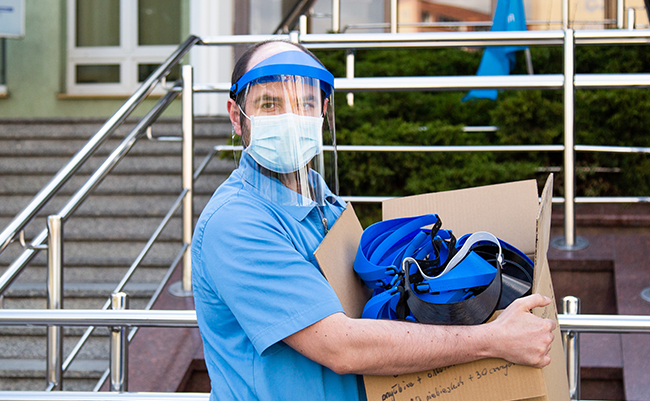
3D printed face shields received at a hospital in Olsztyn, Poland.
Now, in the midst of the second wave, we had to radically scale this up. We’ve got a lot of calls for support coming from hospitals and medical staff. They wanted to know if there was anything else we could do to help. Protective gear, especially face masks were always among things they needed the most.
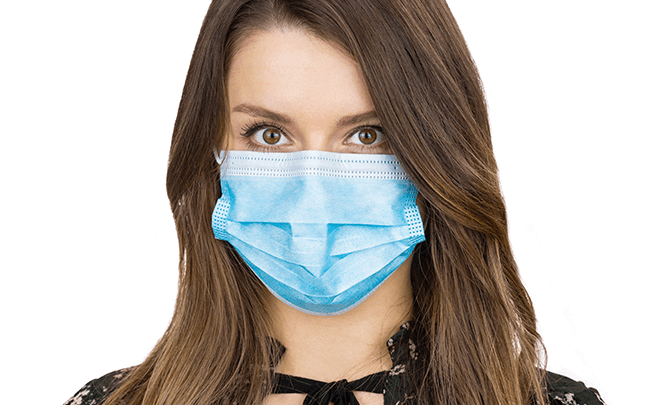
A standard face mask is among the most sought after protective equipment during the second wave of the pandemic.
So, using our resources and engineering expertise, we came up with a plan to set up a fully-functional manufacturing line producing face masks. We knew that traditional manufacturing aided by our 3D printing technologies could increase our manufacturing output by orders of magnitude. So, we set out to work it out. Here’s how we did it.
Setting Up a Manufacturing Line
The line starts with three kinds of fabric which are dispensed from large rolls. This way, by routing the fabric through a folding device that holds the fabric together, we end up with a three-layer cloth which in the form of a mask can efficiently filter the air breathed out by the wearer. At the same time, the system is capable of weaving a wire into the fabric to enable fitting the mask better.

Three cloths are being assembled into one, three-layer material.
At the end of the process, the fabric is transported down the line to the machine that cuts it into pieces that would become single masks. Finally, the last machine attaches strings that placed over ears hold the mask in place. Of course, the masks manufactured this way are not certified. Still, certified masks are hard to come by these days, so medical staff typically use them only in high-risk scenarios. In other cases, they use standard face coverings like everyone else.
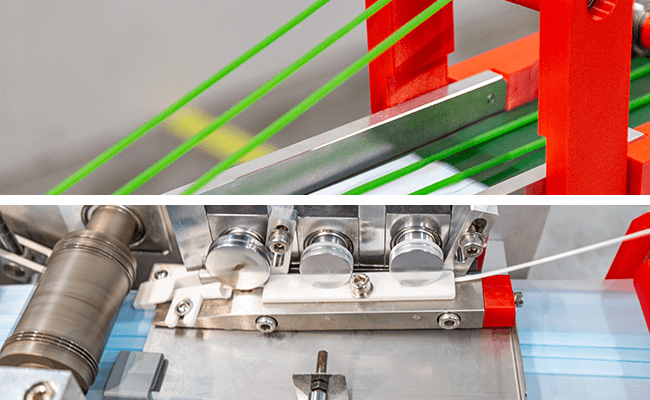
Cutting the wire the enables fitting the masks more tightly.
Such simple yet large scale production line enabled us to significantly increase our output. While using solely our farm of 3D printers, we could make roughly between 200 and 500 face shields per day. With this newly built production machinery, we can now make 500 masks in under 10 minutes. Still, 3D printing played a key part in setting the entire line up.
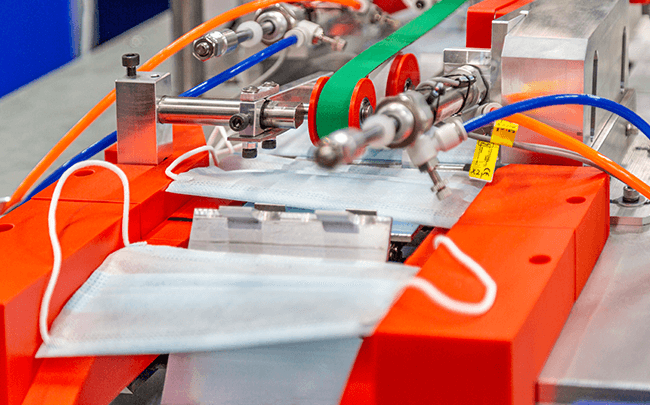
Fully assembled masks coming off the manufacturing line.
Custom 3D Printed Components
The machinery has been acquired in a pretty much standard setup to reduce costs. To tweak it to our needs and available space, we used our 3D printers to fabricate lots of parts that are crucial to functioning of the entire system.
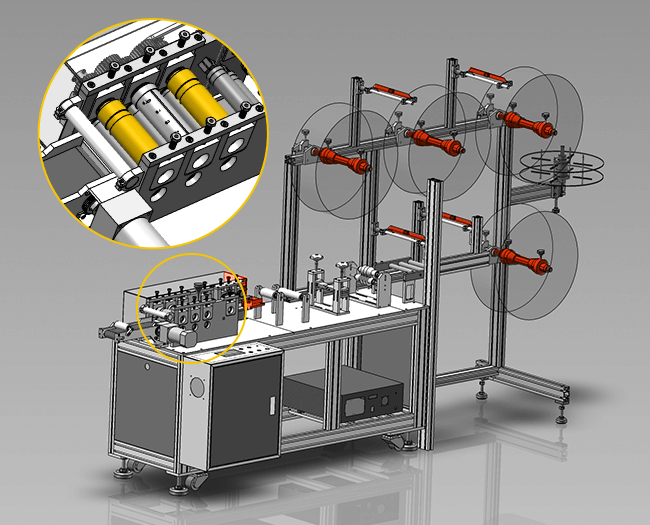
The module assembling three-layer fabric. LPD 3D printed components marked in red. UV LCD 3D printed components marked in yellow.
Red holders keeping the rollers in place are all 3D printed on our M Series Plus machines with Z-HIPS filaments. Printing such customized holders allowed us to choose the right height for the rollers. Furthermore, the yellow rollers themselves have been 3D printed, although this time with our UV LCD machines.

The ear loops welding module. LPD 3D printed components marked in red.
The resin 3D printing technology, as inherently more precise that the LPD and LPD Plus, was chosen for the rollers because these components had to have smooth, high quality surfaces. Also, increased precision was necessary to place them on their axes.
The Way to Help People
At the end of the day, this entire setup is a proof-of concept. It can make 2 masks every second. While this sounds impressive, it obviously is nowhere near the output reached by large factories manufacturing medical devices. Competing with them was not our goal, though. The goal was to help to people fighting the pandemic when they need it the most. Medical staff has enough work on their hands in these difficult times. Dealing with shortages of basic protective gear is not something they should struggle with. We’re glad our technology could make their day to day work just a little bit better.
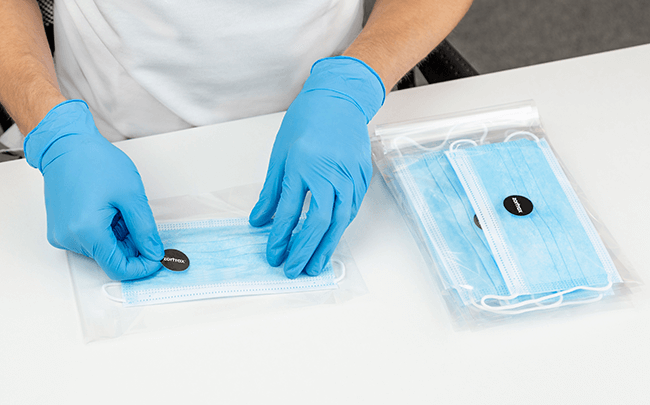
Manufactured masks are being put into plastic bags in which they are delivered to hospitals.
In fact, everyone with a decent 3D printer can aid them as well. Our partners are already using our 3D printers to print Venturi valves, adapters capable of turning popular snorkeling masks into oxygen masks, and casings for wearable respirators. Before committing to something it’s best to get in touch with a local hospital or Red Cross branch and ask what they need at the moment. Every help matters.
Here you can find the models we used in the Fabric Module and in the Ear Loops Module, of our assembly line. The can be used and modified freely.